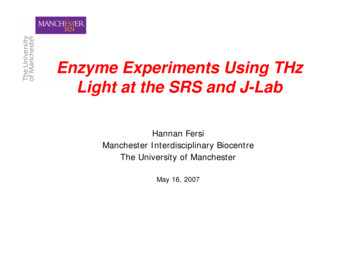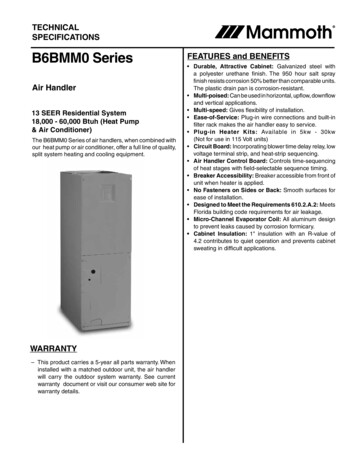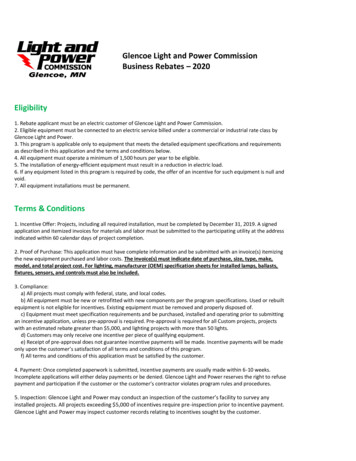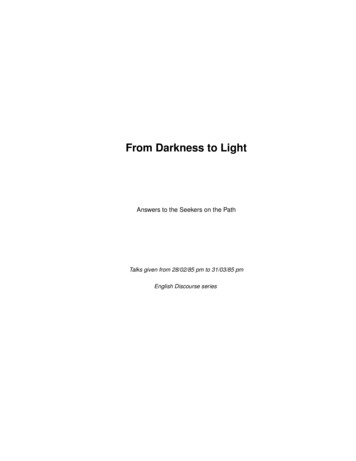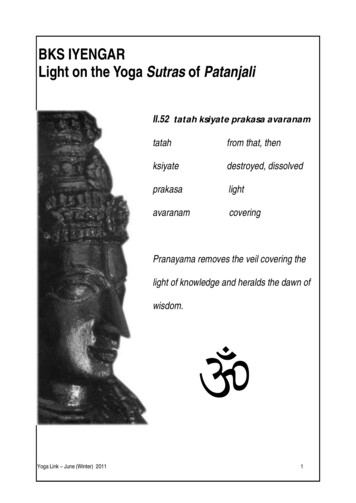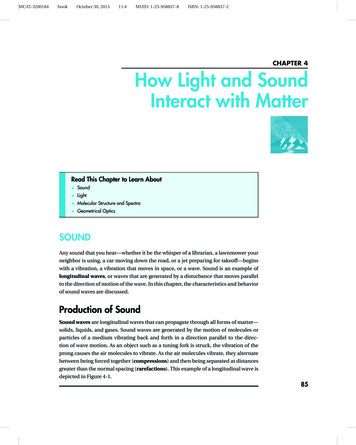
Transcription
MCAT-3200184bookOctober 30, 201511:4MHID: 1-25-958837-8ISBN: 1-25-958837-2CHAPTER 4How Light and SoundInteract with MatterRead This Chapter to Learn About Sound Light Molecular Structure and Spectra Geometrical OpticsSOUNDAny sound that you hear—whether it be the whisper of a librarian, a lawnmower yourneighbor is using, a car moving down the road, or a jet preparing for takeoff—beginswith a vibration, a vibration that moves in space, or a wave. Sound is an example oflongitudinal waves, or waves that are generated by a disturbance that moves parallelto the direction of motion of the wave. In this chapter, the characteristics and behaviorof sound waves are discussed.Production of SoundSound waves are longitudinal waves that can propagate through all forms of matter—solids, liquids, and gases. Sound waves are generated by the motion of molecules orparticles of a medium vibrating back and forth in a direction parallel to the direction of wave motion. As an object such as a tuning fork is struck, the vibration of theprong causes the air molecules to vibrate. As the air molecules vibrate, they alternatebetween being forced together (compressions) and then being separated at distancesgreater than the normal spacing (rarefactions). This example of a longitudinal wave isdepicted in Figure 4-1.85
MCAT-3200184bookOctober 30, 201511:4MHID: 1-25-958837-8ISBN: sionRarefactionsWaveDirection0RarefactionUNIT I:PhysicalFoundations ofBiological SystemsDistanceor TimeFIGURE 4-1 Longitudinal wave. Source: From George Hademenos, Schaum’s Outline of Physics forPre-Med, Biology, and Allied Health Students, McGraw-Hill, 1998; reproduced with permissionof The McGraw-Hill Companies.Relative Speed of Sound in Solids, Liquids,and GasesThe movement of sound requires molecules in a medium. The farther apart themolecules in the medium are spaced, the slower the speed of sound through themedium. Conversely, when molecules are tightly spaced, sound travels the fastest.Therefore, the speed of sound is the fastest in solids (where molecules are tightlyspaced) and faster in liquids than in gases (where molecules are widely spaced).The speed of sound through air is approximately 344 meters/second (m/s;760 miles/hour). In contrast, the speed of sound in water is 1480 m/s.Sound IntensitySound intensity represents the rate of energy transported by a sound wave per unitarea perpendicular to its direction of motion. The sound level β, expressed in units ofdecibels (dB), is defined in terms of sound intensity I as: Iβ 10 logIowhere Io is the threshold for human hearing [ 1 10 12 watts per square meter(W/m2 )] and represents the intensity of the weakest sound detectable by the humanear. The following table lists representative values of sound intensity I and theircorresponding sound level β.
MCAT-3200184bookOctober 30, 201511:4MHID: 1-25-958837-8ISBN: 1-25-958837-287TABLE 4-1 Sound Intensity and Sound Level of Representative SoundsSound Intensity (W/m2 )Sound Level (dB)1 10 121 10 101 10 81 10 61 10 41 10 210204060801001201 1021 104140160Representative SoundsThreshold of hearingDistant whisperNormal outdoor soundsNormal conversationBusy trafficSiren at 30 mLoud indoor rock concert(threshold of pain)Jet airplaneBursting of eardrumsEXAMPLE: A particular sound level was measured at 75 dB. Determine its soundintensity.SOLUTION: Using the expression for the sound level intensity, you have: β 10 logIIo 75 dB 10 log W 121 102mISolving for I yields: W75 dBWI 1 10 12 2 3.16 10 5 2log 110mmAttenuationAttenuation, also known as damping, is a gradual reduction in intensity of the soundwave and a subsequent loss of sound energy. Two primary factors behind attenuationinclude scattering and absorption. As it propagates from its source, the sound wavewill reflect off of or pass around obstacles as it undergoes diffraction. Also, becausesound is a form of energy, sound waves transfer a portion of their energy as they collidewith and is absorbed by surrounding molecules in their path including air molecules.Doppler EffectThe Doppler effect refers to the shift in frequency of a transmitted sound that is causedby a change in distance between the source of the sound and the observer. Considera source emitting a sound of frequency fs detected by an observer as a frequency fo.If the source is moving toward the observer, the observer perceives an increase in thesound frequency. If the source is moving away from the observer, the observer perceives a decrease in frequency. The altered frequency detected by the observer is knownCHAPTER 4:How Light andSound Interactwith Matter
MCAT-3200184bookOctober 30, 201511:4MHID: 1-25-958837-8ISBN: 1-25-958837-288UNIT I:PhysicalFoundations ofBiological Systemsas the Doppler-shifted frequency. These qualitative relationships can be expressed by: v vofo fsv vswhere v is the speed of sound in the given medium.There are several specific cases of the Doppler effect: Moving sound source toward a fixed observer vfo fsv vs Moving sound source away from a fixed observer vfo fsv vs Fixed sound source with observer moving toward source v vofo fsv Fixed sound source with observer moving away from source v vofo fsvEXAMPLE: A police car, in pursuit of a driver suspected of speeding, is travelingat 30 m/s when the siren is turned on, operating at a frequency of 1.2 kHz. Giventhat the speed of sound in air is 344 m/s, determine the frequency heard by astationary or fixed witness as1. the police car approaches the observer; and,2. the police car passes the observer.SOLUTION:1. For the case of the moving source approaching a stationary observer, theDoppler-shifted frequency detected by the observer is given by: m 344 vs 1315 Hzfo fs 1200 Hz mm v vs344 30ss2. For the case of the moving source passing a stationary observer, the Dopplershifted frequency detected by the observer is given by: m 344 vs 1104 Hzfo fs 1200 Hz m mv vs 30344ss
MCAT-3200184bookOctober 30, 201511:4MHID: 1-25-958837-8ISBN: 1-25-958837-289PitchPitch is often associated with the frequency of a sound wave. On a quantitative level,the pitch is given by the frequency of the sound wave. Pitch is also used to describequalitatively how the frequency of the sound wave is perceived by an observer. Theeffect of pitch on an observer can be explained by the approach of an ambulance siren.As the ambulance approaches the observer, the observer notices an increasing pitch;as the ambulance passes the observer, the pitch of the siren decreases.Resonance in Strings and PipesMany objects, such as a tuning fork or plucked string, vibrate at a specific frequency.This frequency is referred to as the object’s natural frequency. When a periodic, external force strikes the object with a frequency equal to the natural frequency of the object,the amplitude of the object’s motion increases and hence energy is absorbed by theobject, a condition referred to as resonance. Examples of resonance can be found inengineering in the analysis of structure failure in response to severe weather/naturaldisasters, in medicine with magnetic resonance imaging and lithotripsy of kidneystones, and in music with the tonal qualities of certain string and brass instruments.Standing WavesConsider a wave generated on a stretched string with one side connected to a rigidsurface. As the wave propagates toward the fixed end, it reflects, inverts, and continues back and forth across the string, causing the string to vibrate. In such instances,two waves (original and reflected waves) of equal frequencies and amplitudes aremoving in opposite directions along the string, creating a standing wave, as shown inFigure 4-2.Original Wave 2NodeNode 4Node AntinodeReflectedWaveFIGURE 4-2 Standing wave. Source: From George Hademenos, Schaum’s Outline of Physics forPre-Med, Biology, and Allied Health Students, McGraw-Hill, 1998; reproduced with permissionof The McGraw-Hill Companies.CHAPTER 4:How Light andSound Interactwith Matter
MCAT-3200184bookOctober 30, 201511:4MHID: 1-25-958837-8ISBN: 1-25-958837-290UNIT I:PhysicalFoundations ofBiological SystemsThe points with no displacement from the horizontal axis are termed nodes, andthe points that are maximally displaced from the horizontal axis—that is, points atthe peaks and valleys of each wave—are termed antinodes. The distance between twoadjacent displacement nodes is one-half wavelength and the distance from node toantinode is one-quarter wavelength. The frequency, f , of a standing wave is given by:f vλwhere v is the velocity of the wave.FREQUENCIES IN A STRETCHED STRINGA stretched string of length L with both ends secured to a rigid surface possesses nodesλat both ends. Because the distance between two adjacent nodes is λ/2, then L or2λ 2L. Substituting this value into the expression for the frequency yields:f vv λ2LThis is the lowest frequency that the string can accommodate and is termed the fundamental frequency, or first harmonic. Harmonic frequencies, second and greater, areinteger multiples of the first harmonic and can be determined from the generalizedrelationf nv2Ln 1, 2, 3, . . .The first, second, and third harmonics are illustrated in Figure 4-3.FREQUENCIES IN A PIPEThe frequencies in a pipe can be derived in a fashion similar to that for the stretchedstring. However, the pipe offers more conditions to consider, such as both ends openand one end open. A node can be found at the end of a closed pipe whereas an antinodeis present toward the open end of the pipe. Given that the distance from node to node isλ/2 and the distance from node to antinode is λ/4, the frequencies for a pipe of lengthL are as follows:Pipe with both ends open:Fundamental frequency:f1 Harmonics:fn Pipe with one end open:λ 4v2Lnv2Lλ4v4Lnv4LL 2L Fundamental frequency:f1 Harmonics:fn λ2n 1, 2, 3, . . .n 1, 3, 5, . . .
MCAT-3200184bookOctober 30, 201511:4MHID: 1-25-958837-8ISBN: 1-25-958837-291Fundamental Vibration(First Harmonic)LWavelengthFrequency 2Lf fo Lf 2f o2f 3foSecond HarmonicThird Harmonic 3LFIGURE 4-3 First, second, and third harmonics of a standing wave in a stretched string.Source: From George Hademenos, Schaum’s Outline of Physics for Pre-Med, Biology, andAllied Health Students, McGraw-Hill, 1998; reproduced with permission of The McGraw-HillCompanies.EXAMPLE: Determine the velocity of waves in an open pipe of 1.3 m length if thefundamental frequency is 225 Hz.SOLUTION: For an open pipe, the fundamental frequency is given by:f1 v2LSolving for v gives:v f1 2L 225 Hz21.3 m 585msCHAPTER 4:How Light andSound Interactwith Matter
MCAT-3200184bookOctober 30, 201511:4MHID: 1-25-958837-8ISBN: 1-25-958837-292UNIT I:PhysicalFoundations ofBiological SystemsBEATSBeats are produced during interference by sound waves at slightly different frequencies. The beat frequency fbeat is equal to the difference in the frequencies of the individual sound waves f1 and f2 orfbeat f1 f2EXAMPLE: Determine the number of beats per second that are heard when twotuning forks of frequencies 256 Hz and 264 Hz are struck simultaneously.SOLUTION: The beat frequency or the difference between frequencies of the twotuning forks determines the number of beats per second, orfbeat f1 f2 264 Hz 256 Hz 8 HzUltrasoundUltrasound refers to a region of sound frequencies that are above the range of frequencies that are audible to the human ear. The range of frequencies of human hearing is 20 Hz to 20 kHz (20,000 Hz). Ultrasound encompasses the range of frequenciesfrom 20 kHz to 20 MHz (20,000,000 Hz). Ultrasound has a variety of applications inthe medical and biological sciences including the assessment of fetal developmentand the diagnosis of cardiovascular and cerebrovascular disease, particularly inquantifying the presence and extent of atherosclerosis within the major vessels of thecirculatory system.Shock WavesShock waves develop when the speed of an object becomes greater than the speed ofsound. In this case, the wavefronts generated by the object surpass the position of thesource, resulting in a cone-shaped formation of successive wavefronts referred to as aMach zone. A shock wave occurs along the surface or edge of the cone, resulting in adrastic decrease in air pressure and a very large increase in sound wave amplitude.LIGHTWe are accustomed to thinking about light in terms of the output of a lamp or a fluorescent lightbulb illuminating a room. This type of light—visible light—represents only avery small subset of the physics definition of light waves, formally known as electromagnetic waves. Electromagnetic waves are an example of transverse waves, meaningthat the direction of the disturbance is perpendicular to or at right angles to the direction of motion. This section introduces the concept of electromagnetic waves, definesthem, and explains their characteristics and behavior as they interact with various surfaces or media, such as mirrors and lenses, to form images (geometrical optics).
MCAT-3200184bookOctober 30, 201511:4MHID: 1-25-958837-8ISBN: 1-25-958837-293CHAPTER 4:How Light andSound Interactwith MatterFIGURE 4-4 Wave interference.InterferenceInterference refers to the superposition of two waves traveling within the samemedium when they interact. When applied to light waves, interference occurs onlywhen the waves have the same wavelength and a fixed phase difference (i.e., the difference in which the peaks of one wave lead or lag the peaks of the other wave remainsconstant with time). These types of waves are referred to as coherent waves. The principle of superposition states that the wave that results from the interaction betweentwo or more waves is the algebraic sum or overlapping of the individual waves, alsoreferred to as superposition. These resultant waves undergo interference, the type ofwhich depends on the phase
MCAT-3200184 book October 30, 2015 11:4 MHID: 1-25-958837-8 ISBN: 1-25-958837-2 86 UNIT I: Physical Foundations of Biological Systems 0 Wave Direction Distance or Time Longitudinal Force Compression Rarefaction Rarefactions Compression FIGURE 4-1 Longitudinal wave. Source: From George Hademenos, Schaum’s Outline of Physics for Pre-Med, Biology, and Allied Health Students,
